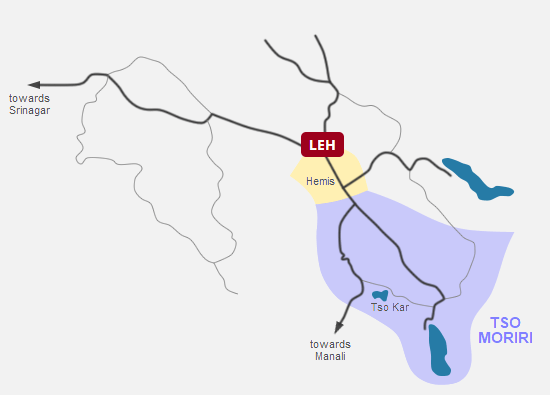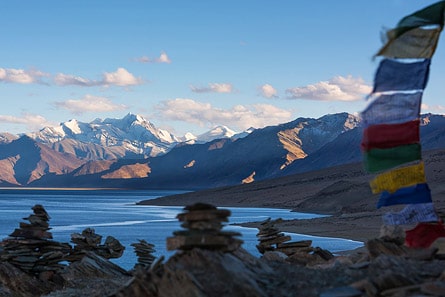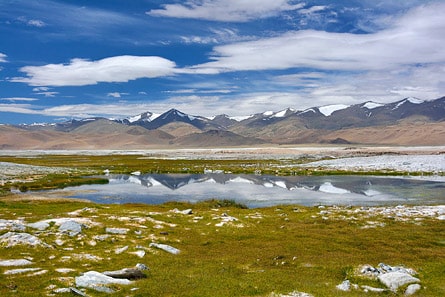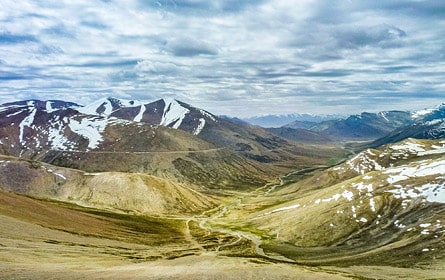

Tso Moriri lake is a breathtaking 26-km-long lake located at an altitude of 4,530 metres above sea level near the border with China. It is surrounded by Himalayan peaks towering at more than 6,000 metres. It is important to be well acclimatized to the altitude before travelling to Tso Moriri lake to avoid risk of altitude sickness. Korzok is the only village located on the shore of Tso Moriri lake, guesthouses and homestays can be found there.
On the way from Leh to Tso Moriri lake, you will stop at Chumathang hot springs. On the way back, you can discover Puga hot springs and Tso Kar lake, a heaven for birdwatchers where you might be able to spot the rare black-necked crane. Then, you will drive through Taglang La pass (5,328 metres) to reach the Indus valley and Leh.
If you have enough time, you can visit the monasteries and palaces of the Indus valley: Hemis monastery, Thiksey monastery, Shey palace, Stakna monastery and Stok palace.
You can choose whether you want to include the visit to Tso Kar lake in the Tso Moriri lake tour:


The Changthang is a part of high altitude Tibetan plateau that extends into southeastern Ladakh with highlands and lakes. Of many emerald lakes, Tso Kar and Tso Moriri are worth visiting. Both the lakes attract a lot of connoisseurs and visitors for its sheer natural beauty. Moreover, the wetlands and marshes around them are breeding grounds for exquisite birds and unique wildlife. Consequently, the bird lovers and wildlife enthusiasts throng these lakes for a glimpse of peculiar Himalayan flora and fauna. Changthang is home to Changpas, a nomadic tribe that moves from one place to another in search of pastures for their livestock. Many monasteries lie along the Indus valley that you can visit while on your way from Leh to the lakes.

Tso Moriri lake, with a backdrop of snow-clad mountains, is the largest among the high altitude lakes in entire India. It is situated at an altitude of 4,530m, stretching up to 26 km long and 8 km wide. This large lake reflects blue sky in the day and heavens in the night. Surrounded by high mountains, green pastures and groves, its sight is divinity to be experienced at least once in a lifetime. Streams from the melting snow of the surrounding mountains and springs get collected in the lake maintaining its water level. Until today there is no evident outlet of this lake, making its solutes settle down on its bed. Hence, making it saline and not potable.
The area around the lake is a part of the wetland reserve under Ramsar site and is known as Tso Moriri Wetland Conservation Reserve. Therefore, pitching tents or any constructions near its banks is prohibited by the law. Nevertheless, the wetland is a hotspot for bird watching and wildlife enthusiasts. Many throngs the place to witness exquisite and unique birds and wildlife of the trans-Himalayas found only in Ladakh. The lake is located near the line of actual control. You would need special permission called ‘Inner line permit’ from the state authority to visit the place.

The Rupshu region of Changthang is situated at an altitude of 4,500m. The region is a chain of mountains dotted with highland lakes. The famed Tso Moriri lake is one of them and the only village by the lake is Korzok. The village is located at the north-west of the lake. It comprises of approximately fifty households. The inhabitants rear livestock. On the agricultural lands, they cultivate oats, barley and vegetables in the few months of summer. The village boasts of a 300 year’s old Buddhist monastery of the Drukpa lineage known as Korzok monastery. Home to seventy monks, it enshrines statues of Buddha and other deities. Korzok Gustok, the monastery festival, is celebrated in the sixth month of the Tibetan calendar.

Tso Kar lake, or the white lake, is a salt lake known for its depth and size. It is situated in the Rupshu plateau of southern Ladakh. Historically, the lake was an important source of salt. Changpa nomads would export the mineral to whole Ladakh and neighbouring countries, especially Tibet. The valley is dominated by two high mountains, Thukje and Gursan; the nomadic settlement of Thukje is located 3km to the north of Tso Kar lake. The marshlands surrounding the lake make it a wonderful spot for birds like Brahminy ducks, bar-headed geese and the great crested grebes. The main attraction though is the famed but endangered black-necked cranes. They migrate from Tibet to the lake for the summer season. Tso Kar lake also attracts wildlife lovers. The most spotted animal is Kiang, the largest of all the wild asses. The area is also home to marmots, ibexes, Tibetan gazelles, snow foxes and snow leopards. The view of Tso Kar is breathtaking, surrounded by mountains and canopied with clear blue skies.
It gets more exciting on a full moon night. The mountains shine with the moonlight and its clear reflection in the lake is surreal to witness. The western bank of the lake is provided with tented camps for tourists and visitors. Homestay in Thukje is the new kind of service that provides accommodation to the visitors, thus augmenting the local economy.

The hamlet of Chumathang is famous for its natural sulphur hot springs. These mineral-rich hot springs have a long wellness-and-medicinal tradition known to treat skin diseases and joint pains. The oozing bubbles and hot steam make a bewildering sight, especially during the colder climate when the nearby Indus river freezes of sheer cold. Chumathang village is situated in the relatively lower altitude, making it a good stop for the travellers. One can find a few eateries with local food and a hot spring resort with basic facilities.

Taglang La is the highest mountain pass, situated at 5,328m above sea level, on the national highway connecting Ladakh and Manali. Considered among the highest motorable passes in the world, it offers a wide array of scenic beauty as you proceed farther away from human settlements. The journey over the Taglang La pass is not only a pleasing offer to nature lovers but also a thrilling experience for adventurers. The whole stretch is bound with rocky precipices that change in hue and colour at every precarious turn and juncture. While travelling on the pass, it is advisable to take precautions for altitude sickness and not to spend too much time at the top.

Hemis gompa is the largest monastery in Ladakh. Situated 43 km to the south of Leh, it is also the richest. The gompa belongs to the Drukpa lineage of Tibetan Buddhism. King Sengge Namgyal established the monastery in 1672, while Lama Stagtsang Raspa performed its consecration. The annual festival honouring Guru Padmasambhava, a yogi and scholar of Buddhism, is another reason for tourists to visit the monastery. The two days affair is celebrated with cham (mask) dances by the monks. After every 12 years, a huge thangka is unfurled during the festival attracting hordes of believers to witness and receive its blessings. The gompa has a museum with a huge collection of artefacts, Buddhist scriptures, thangkas, statues, weapons and so on.

This large monastery sits perched on a hilltop some 20 km away from Leh. Thiksey monastery was built in 1430 AD under the patronage of King Takpa Bumde and guidance of Lama Palden Sherab. It belongs to the Gelugpa school of Tibetan Buddhism. The gompa enshrines an impressive 14m-tall statue of Maitreya Buddha, also known as the future Buddha. It towers to three floors of the monastery and took 4 years to build. The monastery complex holds many significant shrines that are accessible for tourists and visitors to witness and worship. Thiksey gompa hosts Thiksey Gustor, its annual festival, with sacred mask dances and spiritual rituals and practices.

Shey palace cum monastery is yet another attraction for tourist in Ladakh. Located some 14 km away from the city, the palace served as the abode of the royal families till 1834 AD. The old palace was built by Lhachen Palgyigon, the king of Ladakh in the 10th century, who established his capital at Shey. The new palace and monastery complex was, however, built in the 17th century by King Deldan Namgyal in the memory of his father King Sengge Namgyal. The monastery has a 12m-tall statue of Shakyamuni Buddha made out of copper and gold.

‘Stakna’ received its name from the shape of the hill, over which it is perched, resembling the nose of a tiger. The Stakna monastery sits on the secluded hill in the Indus river bed some 23 km from the city, thus affording a spectacular view of the valley and its villages. The monastery belongs to the Drukpa lineage. It was founded by Chosje Modzin, a Bhutanese scholar, in the 17th century. The gompa houses a stupa portraying a figure of the Buddha with some inscriptions. Murals, frescoes and wall paintings are the other highlights of the beautiful monastery.

Stok palace is situated in Stok village, some 16 km from Leh city. Built in 1822 AD, at the fall of Ladakh kingdom, it serves as the royal residence even today. The palace has a museum with an impressive collection of ancient artefacts, coins, relics, royal seals, costumes and so on. Stok is also famous for its monastery located around 2 km from the palace. Lama Lhawang Lotus founded the monastery in the 14th century. It has a library that boasts 108 volumes of Kangyur, the sacred texts of Buddhism. A 22m-high statue of seated Gautama Buddha has been recently constructed near the monastery.
The best time to visit Ladakh is in the summer season, i.e. between April to September, though some places are accessible throughout the year. Tso Moriri and Tso Kar Lakes can be visited anytime, however proper precautions and arrangements should be made for cold and altitude sickness. These lakes and Rupshu plains are part of the highlands of Himalayas which have severe winter. The access to these regions from Chumathang remains open all seasons, but another portal via Taglang la closes from November to end of April owing to heavy snowfall and landslides. Due to severe cold, the lake freezes in the winter when the temperature drops to negative.

The Changthang is the highest region of Ladakh, with an altitude of 4,500m and above. Tso Moriri lake itself lies at an elevation of 4,530m. Therefore, it is important to be well acclimatized to the altitude before travelling to this area. It is recommended to spend minimum 4 days travelling in other parts of Ladakh at lower altitude (Leh, Indus valley, Nubra valley) before heading to Changthang and Tso Moriri. It is also advised to rent an oxygen cylinder that can be used to alleviate the symptoms of AMS.
A good option is to visit Tso Moriri lake at the end of your trip in Ladakh. The visit to Tso Moriri can also be done as a side trip on the journey from Leh to Manali. However, note that travelling directly from Manali to Tso Moriri at the start of a trip in Ladakh is not possible.
Tso Moriri lake is located near the border with China (Line of Actual Control). Therefore, a special permit is needed to travel to this part of Ladakh. This permit called ‘Inner Line Permit’ can easily be obtained from Leh in one working day.
While travelling to Tso Moriri lake from Leh, you will receive good phone signals until Upshi. They grow sparse and intermittent until Chumathang village. On the whole journey, Chumathang is the last post to receive calls and internet signals. We suggest you make the update calls and messages to your loved ones or business before crossing the village because from then on, there is no semblance of mobile or internet connectivity in the rest of the region.
There are very few villages in the Changthang region and accommodation options are very limited. Near Tso Moriri lake, Korzok village offers the widest range of options with several homestays and guesthouses. Most of these places do not have an internet website and it can be complicated to book a room in advance. You can look for a room directly when you reach Korzok with the help of your driver. A couple of hotels and camps such as Rupshow Residency and Nomadic Life Camp can be found in Korzok village too.
Simple accommodation options are also available in Thukje village near Tso Kar lake. They are ideally located for those who want to spend time at Tso Kar lake to observe the wildlife and do birdwatching. For example, you could check out Lotus Camp and Druk Resort.

From Leh, drive to Hemis and visit the famous monastery. Then, head to the Changthang region and stop at Chumathang where you can see the hot springs and have your lunch. Drive another 73 km to reach Korzok village. Enjoy the beautiful scenery at Tso Moriri lake. Night in Korzok.
Drive to Tso Kar lake where you might spot a black-necked crane and other birds. Head back towards Leh via the Taglang La pass. Before reaching Leh, visit Thiksey monastery and Shey palace.
Note: If you want to spend one full day at Tso Moriri lake (with 2 nights in Korzok village) and/or if you want to have more time at Tso Kar lake and for visiting the monasteries and palaces of the Indus valley, you could do this tour in 3 days or even in 4 days.
In the morning, visit Hemis monastery and drive to Chumathang hot springs where you can stop for snacks and tea. Spend the afternoon exploring the breathtaking Tso Moriri lake and its surroundings. Night in Korzok.
Enjoy the sunrise over Tso Moriri lake. You can also take time to visit the Korzok monastery. Drive back to Leh and visit Thiksey monastery and Shey palace on the way.
Note: Similarly to the previous tour, you could also do this tour in 3 days or 4 days.
